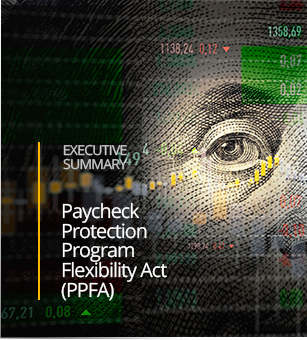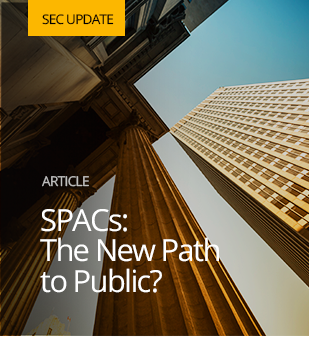New legislation provides flexibility in forgiveness and repayment terms for PPP Loan Borrowers.
On June 5th, 2020, the Paycheck Protection Program Flexibility Act (PPFA) was signed into law, providing additional flexibility in the forgiveness and repayment terms of this popular Paycheck Protection Program created by the CARES Act.
In the following we will describe many of the key changes and what they mean for PPP loan borrowers.
Key Points from the Paycheck Protection Flexibility Act (PPFA)
PPP Loan Use “Covered Period” Extended to 24 Weeks
The “covered period” during which PPP loans can be used has been extended from eight weeks to 24 weeks, from date of loan origination. Loan recipients may choose to maintain the eight week timeline. There is a hard cap of December 31, 2020.
What it means: The original eight-week period PPP loans were to be used in has proven insufficient as the economic fallout from the COVID-19 pandemic has continued for many businesses. The extended deadline is meant to help businesses maximize the forgiveness potential of the loans. The ability to adhere to the original eight-week deadline is also notable, as businesses that have recovered will be able to seek forgiveness when they are ready.
Payroll Expenditure Requirement Lowered to 60%
Borrowers now need to use 60% of funds to support payroll to meet forgiveness requirements. The prior level was 75%. However, the 60% limit now becomes a cliff, meaning at least 60% of funds MUST be used on payroll or there is no loan forgiveness.
What it means: One of the biggest criticisms of the original PPP loan terms was the 75% usage requirement for maintaining payroll, as many businesses had other pressing needs (rent/lease payments, supplier payments, utilities, etc.) superseding or directly connected to the need to maintain payroll levels. Lowering the payroll threshold to 60% is useful, while also reemphasizing the purpose of the loans being for maintaining payroll through implementing the “cliff” dynamic.
Deadline for Restoring Full Workforce Extended to 24 Weeks
Borrowers now have 24 weeks, or a hard deadline of December 31, 2020, to meet the forgiveness condition of restoring workforce levels to pre-pandemic levels. Previous deadline was June 30, 2020.
What it means: As the economic fallout from the COVID-19 pandemic continues, this is a very welcome change, as many borrowers are not yet near former operational levels. This makes returning workforce to pre-pandemic levels nearly impossible for many borrowers.
More Exceptions for Restoring Workforce Forgiveness Condition
If a PPP borrower cannot restore prior workforce levels due to the inability to find qualified help, or have not restored prior business operations to pre-pandemic levels, their loans remain eligible for forgiveness.
What it means: Previous guidance allowed borrowers to exclude from payroll calculations employees who turned down ‘good faith’ offers to be rehired at pre-pandemic hours and wages. Creating two further exceptions makes sense as many businesses may not be able to return to previous workforce levels, possibly for years to come. Businesses seeking these exclusion will need to be able definitively document these conditions when seeking forgiveness terms through their lender.
PPP Borrowers Have Five Years to Pay Back Loans
PPP loans can be extended to five years if borrower and lender agree. The previous timeline was two years. Loans extended to five years will maintain the 1% interest rate.
What it means: Additional flexibility in repayment terms is another welcome change as economic conditions remain difficult for many businesses.
PPP Borrowers Can Delay Payroll Taxes
PPP loan recipients are now eligible for the payroll tax deferral created by the CARES Act. Previously, receiving PPP loans disqualified businesses from the payroll tax break.
What it means: In the CARES Act legislation that created the PPP program, there were tax credits and incentives designed to help struggling businesses. One essential option was the ability to defer the deposit and payment of the employer’s portion of social security taxes that otherwise would be due between March 27, 2020, and Dec. 31, 2020. Employers could instead to deposit half of deferred payments by the end of 2021 and the other half by the end of 2022.
Support for Maximizing PPP Loan Forgiveness
The Payroll Protection Program Flexibility Act provides much needed flexibility to businesses that have taken loans out in the face of unprecedented economic disruption. These changes to terms represent a moving target for businesses seeking to use funds as directed, in many cases increasing complexity. But overall these changes are welcome and ultimately create expanded opportunities for maximizing PPP loan forgiveness.
If you have any questions about PPP loans, forgiveness terms, or related issues, our dedicated team is ready to provide guidance. Please do not hesitate to reach out to us with any questions: contact us.


